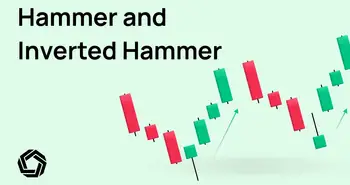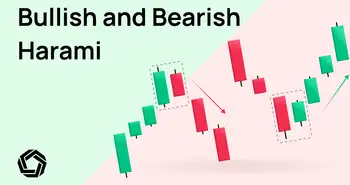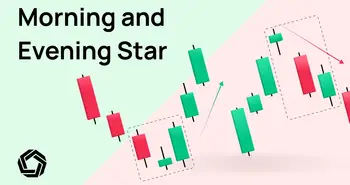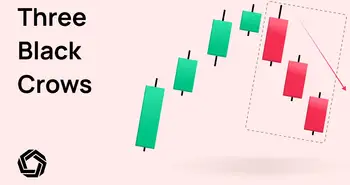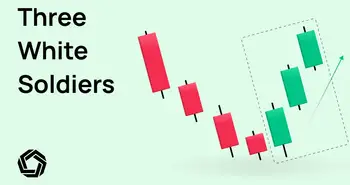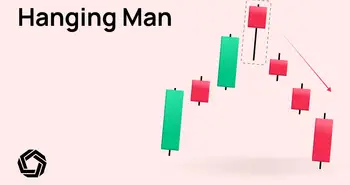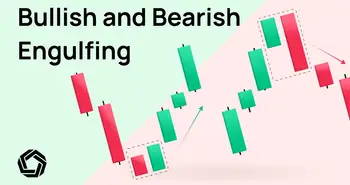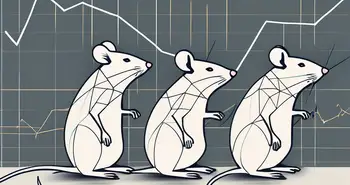Tweezer Top and Bottom Patterns
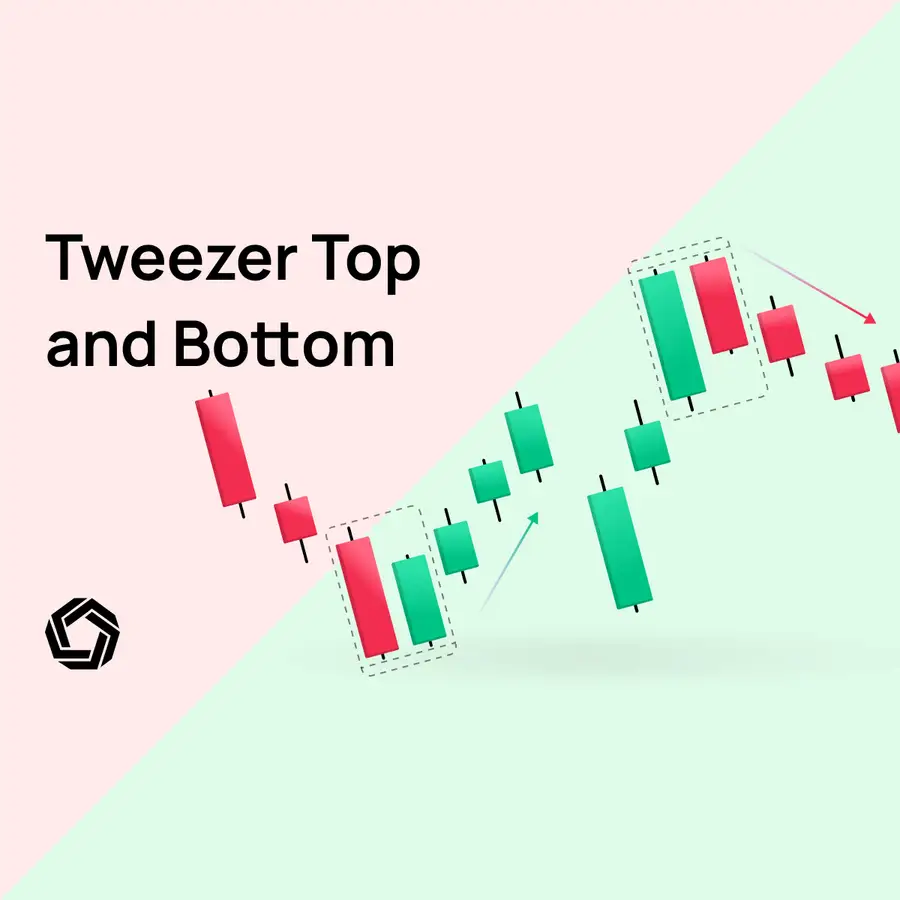
The Tweezer Top and Bottom, or just Tweezers, are two well-known patterns. We will examine both in this post and provide essential tips for using them in your trading approach. Even though they are not always so easy to spot, we will give you a great overview of how to spot and include them in your trading arsenal. Also, a great trader needs a broad portfolio, so we'll give you three alternative trading approaches specifically suited to markets like Stocks, Cryptocurrencies, Commodities, Forex, and even NFTs.
In general successful trading with candle charts requires an understanding not only of the candle patterns but also of where the candle pattern appears and in the context of risk/reward analysis. Before placing a trade based on a candle pattern, one should always consider the risk/reward aspect.
Tweezer Top Pattern
The Tweezer Top Pattern is formed when two or more successive candlestick highs match. The pattern resembles the two prongs of a tweezer, hence the name. The Tweezer Top can be composed of real bodies, shadows, or doji, and is most effective when the first candlestick is long with a small real body for the second candle. This pattern signals a shift in market momentum and a potential trend reversal as bears begin to take control of the bulls.
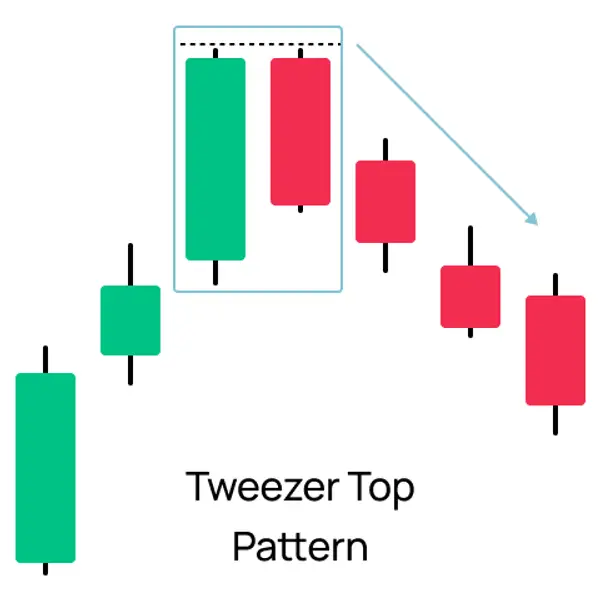
The graphic above shows the perfect pattern. However, the pattern can vary a bit; sometimes, the shadows might not align perfectly, or the real bodies might not align, but the shadows align. So, keep in mind that a slight leeway is possible with the tweezer pattern. Thus, waiting for confirmation from other technical indicators is essential to maximize the pattern's effectiveness.
What Does a Tweezer Top Pattern Look Like?
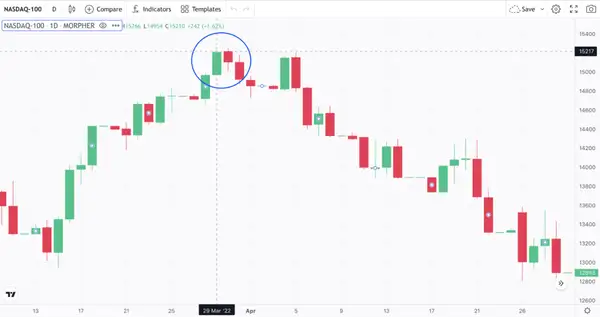
Tweezer Bottom Pattern
The Tweezer Bottom Pattern is characterized by two or more successive candlestick lows matching. A perfect Tweezer Bottom Pattern involves a long first candle with a small real body for the second candlestick. This pattern indicates a potential reversal in the prevailing trend, with the bulls gaining strength over the bears.
However, a Tweezer Bottom Pattern should not be used in isolation, and investors should also look for a bullish candlestick signal to confirm the pattern.
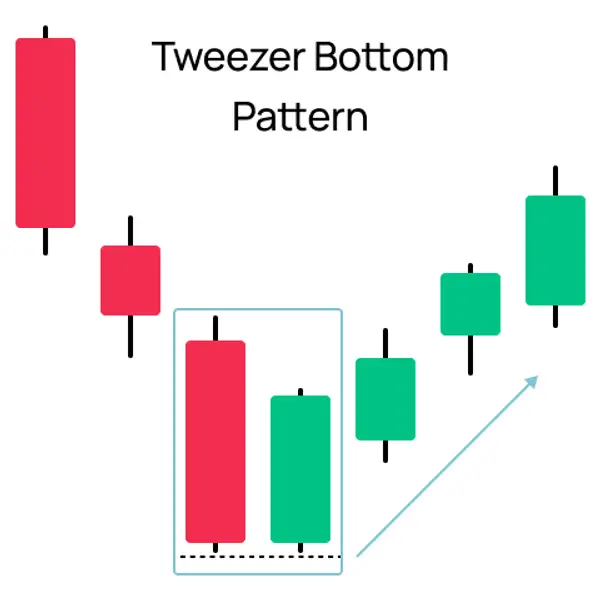
What Does a Tweezer Bottom Pattern Look Like?
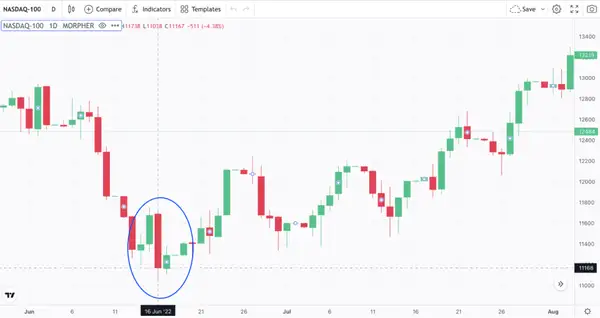
Tweezer Top and Bottom Pattern Strategy Ideas
The following three strategies are universal and can be applied to any asset class.
Strategy 1: RSI Indicator
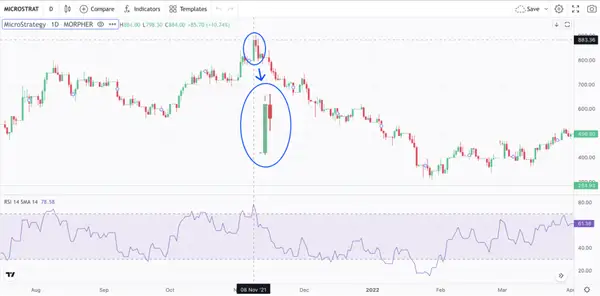
For the first strategy, we use the RSI to identify overbought patterns and Tweezer Top Patterns. The RSI measures the strength and momentum of an asset's price action, with a reading above 70 indicating that the asset is overbought and a reading below 30 suggesting it's oversold.
In this case, we trade Microstrategy (MSTR) to demonstrate a live scenario in the charts. It's worth noting that the stock is highly correlated with Bitcoin since the company holds a significant amount of Bitcoin on its balance sheet.
In this particular case, the pattern is clearly visible and confirmed by the RSI indicator. There's an overall uptrend, and a new top is formed on November 8, 2021, with a long green candle. The following day, we see a reversal with the same top and a small red real-body candle, indicating a potential Tweezer Top.
The RSI confirms that the asset is overbought, with a value of around 75. Waiting for the next candle on the daily chart can provide confirmation of the trend pattern. A good entry position for a short trade might be around the 700 mark, which could continue until around the 400 mark, where the RSI turns in the opposite direction with a value below 30.
Trading Rules:
- Look for an uptrend
- Look for a rising RSI
- Spot the Tweezer Tops
- Confirm an overbought RSI (Above 65/70)
- Set a Stop Loss above the Top
- Short the Stock
Strategy 2: SuperTrend and ZigZag Indicator
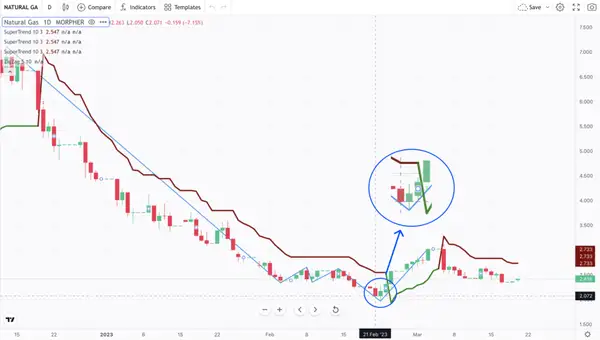
The second strategy involves using the ZigZag and Supertrend indicators to identify potential trend reversals. Here we are showing a possible scenario on the natural gas chart.
The ZigZag indicator helps to filter out market noise and identify significant price movements. It connects swing highs and lows in a zig-zag pattern, highlighting price reversals and trends.
The SuperTrend identifies the current trend and potential entry and exit points. It uses the average true range and a moving average to calculate a band above or below the price, which can help you determine the direction of the trend. If the band is green and below the price, it indicates a buying opportunity; if it is brown/red and above the price, it is a selling signal.
As you can see from the charts, a downward trend has been ongoing for months. You can see the downward trend from the beginning of the chart. On February 21st, a Tweezer Bottom is starting to form. Here, the pattern is imperfect; the first candle is not very long, and the next green candle does not align perfectly. However, in combination with the other indicators, it shows to be more reliable and a good opportunity for a long trade.
The first indicator showing promise is the ZigZag indicator, which turned long. It does not give us any indication if the trend will continue to be long, just that a new low has been formed and that we might take a long trade. If we solely relied on the ZigZag and the pattern, we might have taken a profitable trade that moved from the 2$ mark to the 3$ mark within two weeks.
On a side note, a Tweezer Bottom pattern formed before in the downtrend, such as around January 5th or the 10th. However, the lack of a reversal in the ZigZag indicator precluded any trades at the time.
Also, as the ZigZag indicator tends to lag slightly behind and is not a long-term trend indicator, it is essential to rely on a second trend indicator like the Supertrend. The Supertrend indicator remained on the downtrend with the previous week's Tweezer Bottom Pattern but changed with the show of our Tweezer Bottom Pattern on the 21st.
If you had taken that long trade and waited for every confirmation, in the worst-case scenario, you would have profited from around 2.3$ to 2.6$. However, the possibility was there to make a greater profit, especially if you had protected yourself with a stop loss at the 2.8 level, just below the last top indicated by the ZigZag.
Trading Rules:
- Look for a downtrend in the charts
- Spot the Tweezer bottom
- Wait for the Supertrend to confirm
- Spot the ZigZag reversal
- Set a stop loss a bit below the ZigZag
- Go Long the Commodity
How to Spot a False Tweezer Bottom Pattern
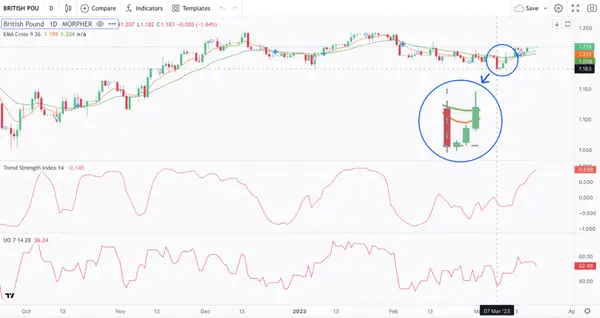
The third strategy utilizes three indicators – the EMA Cross, the Trend Strength Index, and the Ultimate Oscillator. The strategy shows how to spot a false tweezer bottom. We provide you an example where the Tweezer Bottom Pattern showed, but the indicators did not match, thus showing when not to take a trade. Here, we were trading the British Pound/USD pair; however, you could apply this strategy to almost every asset.
The EMA Cross uses two exponential moving averages (EMAs) with different time periods (9 days & 26 days) and plots them on a chart. When the shorter EMA crosses above the longer EMA, it suggests a bullish trend, while a cross below indicates a bearish trend.
The Trend Strength Index (TSI) uses the difference between two smoothed moving averages of the price to calculate momentum, with a positive value indicating a bullish trend and a negative value indicating a bearish trend. It has a neutral value at 0, with a downtrend going below and an uptrend going above.
The Ultimate Oscillator (UO) combines three different time periods of moving averages and uses them to calculate buying and selling pressure. A low level is around 30, and a high level around 70.
Let’s start with an explanation of why it would not be advisable to take the trade. On March 07, the Tweezer Bottom pattern shows, but the other indicators do not confirm the entry. Here, the market has been trading sideways for a while and is coming from a previous uptrend. This does not really support the needed downtrend for the Tweezer Bottom pattern.
Moreover, the EMA Cross did not confirm the outbreak in the shorter timeframe as the orange line did not cross the green one. Also, the Ultimate Oscillator and the Trend Strength Index do not show a true bottom, as they remain rather neutral compared to the previous swings. Even though the UO might indicate some type of bottom, the TSI has a value of 0 at that point, showing no bullish indication. As a result, we would not recommend taking this trade as we do not see any indications of a favorable risk/reward ratio.
Trading Rules:
- Spot the trend
- Spot the Tweezer pattern
- Check if the pattern is actually valid with other indicators
- Trend Strength is high, above 0.5 -> NO
- Ultimate Oscillator is low, below 30 -> NO
- EMA Cross Shows -> NO
- Do not take the Trade
Best Platform to Trade Candlestick Patterns
When trading candlestick patterns, having the right platform is crucial to success. Here are some key factors to consider when choosing the best platform:
- Maximum Flexibility: Look for a platform that allows you to go long or short on any asset and use leverage to profit from even the smallest signals in any direction.
- Variety of Assets: A good platform should offer a diverse range of assets to trade from, including stocks, cryptocurrencies, commodities, forex, and unique markets. This ensures you can always find useful patterns and profitable markets to trade.
- Great Indicators and Advanced Chart View: The platform should have great indicators and an advanced chart view that allows you to save templates you have created and combine multiple indicators to get the best edge possible.
- Infinite Liquidity: Choosing a platform with infinite liquidity is important, so you can close every position at the exact price you aimed for and have no slippage.
- Zero Fees: Look for a platform that offers zero fees, so even if you want to scalp some quick profits, you do not lose on the fees. Combined with fractional trading, you can get in on every position for less than $1.
If you're looking for a platform that offers all of these features, Morpher is a great choice. It's specifically designed to provide the best trading experience possible, with maximum flexibility, a wide range of assets to trade, great indicators and an advanced chart view, infinite liquidity, and zero fees.
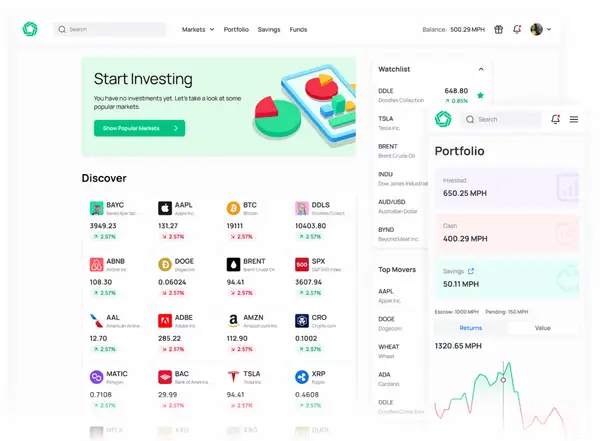
Conclusion
In conclusion, these patterns have proven to be valuable tools for making profitable trades. By incorporating the Tweezer Top and Bottom patterns into your trading strategy and using technical indicators to identify market trends, you can maximize your chances of making informed trading decisions.

Disclaimer: All investments involve risk, and the past performance of a security, industry, sector, market, financial product, trading strategy, or individual’s trading does not guarantee future results or returns. Investors are fully responsible for any investment decisions they make. Such decisions should be based solely on an evaluation of their financial circumstances, investment objectives, risk tolerance, and liquidity needs. This post does not constitute investment advice.

Painless trading for everyone
Hundreds of markets all in one place - Apple, Bitcoin, Gold, Watches, NFTs, Sneakers and so much more.

Painless trading for everyone
Hundreds of markets all in one place - Apple, Bitcoin, Gold, Watches, NFTs, Sneakers and so much more.

